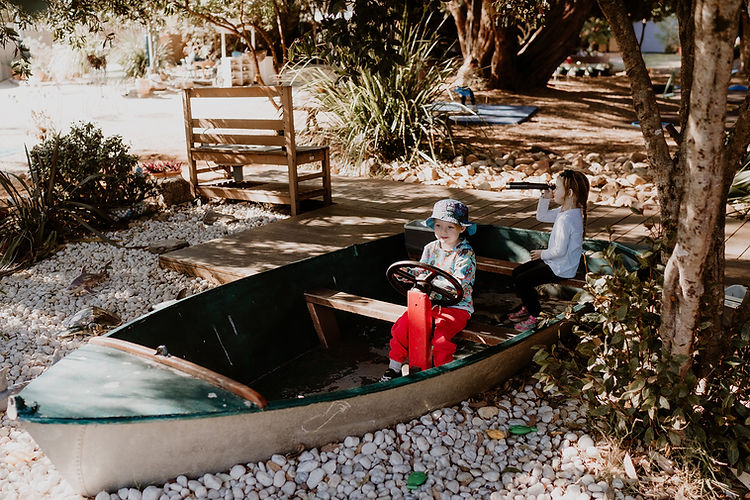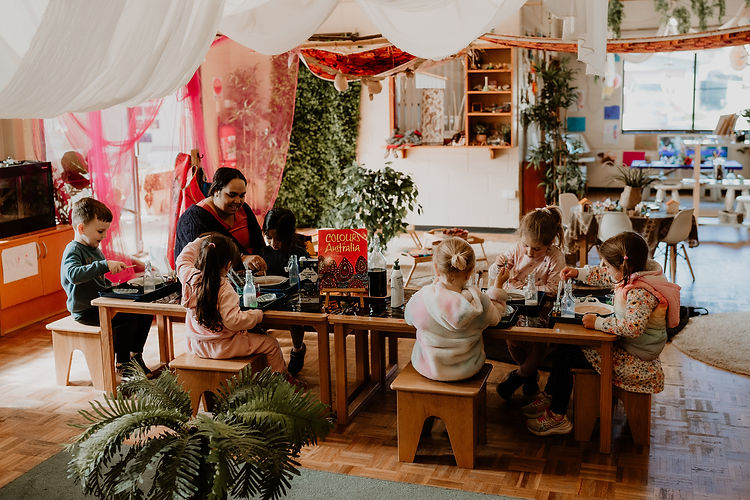

Our Program


Program Outcomes
The Framework supports a model of curriculum decision-making as an ongoing cycle. This involves educators drawing on their professional knowledge, including their in-depth knowledge of each child.
To support and enrich all children’s learning experiences we incorporate;
The 8 Ways of Aboriginal Learning
Aboriginal and Torres Strait Islander peoples are the longest surviving Indigenous culture in the world and the custodians of this land. Their knowledge systems, traditions, ceremonies, lore and culture have survived for over 60,000 years. Relationships and continual connections to Country and community are at the heart of who they are and the contributions of Aboriginal and Torres Strait Islander people – past and present – should be acknowledged and valued in children’s learning.
BELONGING, BEING & BECOMING: The Early Years Learning Framework for Australia – V2.0, 2022
The 8 Ways of Aboriginal Learning supports us to do this and was initially developed by a body of communal expertise held by the traditional keepers of knowledge in Aboriginal communities throughout western NSW. Aboriginal and non-Aboriginal educators contributing to the framework in an ongoing cross-cultural dialogue. The framework is intended to be used as a culturally safe point of entry for educators to begin engaging with Aboriginal knowledge and cross-cultural dialogue in any local community. This is a pedagogy framework that allows us as educators here at the preschool to include Aboriginal perspectives by using Aboriginal learning techniques.
AET team at the Bangamalanha (Wiradjuri word for Sharing) Centre, Dubbo


Program Objectives
The group program objectives are developed in consideration of the required legal documents/framework, our preschool philosophy, educational theorists, parents and consulting children. They form the basis of planning for daily group/individual experiences and the learning environment. You will find a direct relationship between the group/individual objectives and the presentation of the various learning spaces throughout the preschool environment.
The early years of learning framework
The Framework forms the foundation for ensuring that children in all early childhood education and care settings experience quality teaching and learning. It has a specific emphasis on play-based learning and recognises the importance of communication and language (including early literacy and numeracy) and social and emotional development. The Framework has been designed for use by early childhood educators working in partnership with families, children’s first and most influential educators.
“If we allow people to shape their own small worlds during childhood they will grow up knowing and feeling they can participate in shaping the big world.” Sobel. 1990 p.12
Through play children develop a positive sense of self and values, knowledge and skills to lay foundations for the next phase of their lives. Fundamentally play provides children with a secure sense of belonging and gives them the freedom and the confidence to be uniquely themselves in the present and shapes who they can become.
Play is the heart of our philosophy. Children’s interests and emerging ideas are the foundation of our play-based learning and its assessment.
The Framework conveys the highest expectations for all children’s learning from birth to five years and through the transitions to school. The Framework puts children’s learning at the core and comprises three inter-related elements: Principles, Practice and Learning Outcomes. All three elements are fundamental to early childhood pedagogy and curriculum decision-making. It communicates these expectations through the following five Learning Outcomes:
-
Children have a strong sense of identity
-
Children are connected with and contribute to their world
-
Children have a strong sense of wellbeing
-
Children are confident and involved learners
-
Children are effective communicators
The Framework supports a model of curriculum decision-making as an ongoing cycle. This involves educators drawing on their professional knowledge, including their in-depth knowledge of each child.
Working in partnership with families, educators use the Learning Outcomes to guide their planning for children’s learning. In order to engage children actively in learning, educators identify children’s strengths and interests, choose appropriate teaching strategies and design the learning environment.
At the Narooma Preschool we encourage parents to participate in partnership with our educational team through the contribution of information about their child as recorded in the Enrolment forms where family background, culture and values are identified so that they may be respected and affirmed in the preschool community. Parents are encouraged to provide daily feedback through direct conversations with educators, in the space provide in each daily diary and by email.


Areas of learning
Math
Math language will be promoted in all experiences involving a variety of concepts.
-
Basic numeracy
-
Shapes 2D and 3D / size
-
Tessellations / patterns
-
Measurement / timelines
-
Space / volume
Science
Science concepts will be engaged in through experiments, discussion and literature.
-
Magnets
-
Weight, gravity and force /movement
-
Weather
Literacy and Language
Prewriting and reading exercises.
-
Expressive and receptive language development through dramatic play scenarios, puppetry, sequence stories, recounts and retelling.
-
Speaking and listening experiences
-
Reading stories, sharing stories making picture books with dictated stories.
Health and Wellbeing
-
Group games that promote social interaction developing collaboration, problem solving and following rules.
-
Games that promote understanding of healthy eating and personal hygiene.
Creative Arts
-
Self-expression of a variety of emotions and ideas.
-
Basic fine motor skill development.


Assessment & Evaluation
Assessment and evaluation are part of our ongoing programming cycle that includes observing, documenting, analysing, planning, implementing and critical reflection.
When we talk about assessment we mean the gathering of information about your child’s learning, development and wellbeing, undertaken overtime using a range of strategies.
There are 3 broad types of assessment that we use;
-
Assessment ‘for your child’s learning’
-
Assessment ‘of your child’s learning’
-
Assessment ‘as learning’.
Evaluation is used by educators to describe your child’s actions, interactions and communications to consider their achievements, capabilities and wellbeing in relation to the 5 Learning Outcomes.
Each educator will critically reflect on, and analysis all information gathered, and it will be considered in their effectiveness of their planning and implementation of curriculum for your child’s learning.


Critical Reflection
Building a Culture of Critical Reflection
A robust culture of critical reflection is established when educators as a team, as well as children and families are all involved in an on going cycle of review. Current practices are examined, outcomes of those practices evaluated, new ideas generated, tried and tested. This approach supports educators to question established practices and to think about why they are working in particular ways.
Brookfields; “Four Lenses: Becoming a Critically Reflective Educator.”
Self
-
This is the foundation of critical reflection
-
Your past experiences
-
What you hope for the future.
Colleagues
-
Mentoring, advice and feedback
-
Your peers know your strengths and your weaknesses.
Children
-
Engaging with feedback from them
-
Promoting children equity
-
Empathise with them.
Theoretical Literature
-
Advanced thinking and educator practice
-
Ensuring we are deliberate, intentional and purposeful.


Consulting Children
We believe that consultation with children in relationship with their learning is important because;
-
It creates a closer match between the child and the curriculum it is experiencing.
-
It builds self-esteem and positive attitudes when the learner is involved in the decision making.
-
It increases intrinsic motivation that stays with a child throughout life.
-
Children have a right to be treated with respect. As individuals, we can show respect by valuing their thoughts and opinions. (Claire Warden 2006)
The role of the Educator
Children will tell you what they think if they;
-
Feel valued
-
Are given time
-
Know that you will accept their thinking without judgement
-
Can communicate in the best way for them
-
Can tell you when they feel the time is right
-
Know that you are really interested
-
See you looking at them
-
Know that you are listening to them
See their ideas/suggestions actually being used know something about the subject you are questioning them about.


Community Circles
Circles of Community
Circles of Community are open community sessions that promote talking and listening to children. Each session aims to build within each child a sense of equity, a time when children are invited to consider a provocation, an intentional teaching moment or spontaneous event.
In Community Circles talking and listening are developed when:
-
Children’s ideas and thoughts are used without re-framing or interpretation so that they are a genuine record of their thinking. When the idea or thought is removed from the rest of the thinking group, the idea needs to be recorded as evidence of a contribution, but not engaged.
-
Open ended questions will be created in response to an interest from the children. The questions will be posed as part of a conversation and are designed to stimulate thought rather than test knowledge. The flow of reflective talk is critical to the process, to create a partnership of exploration and discovery. Questions and answer sessions have a philosophical sense about them, “I wonder what would happen if…?”
-
Higher order thinking: This level of interest can be stimulated by challenging children to create links in their own learning. Revisiting ideas over long blocks of time support children to see that the process of thinking and learning is full of experimentation and adaption. Our discussions with them are a method of finding out what they know before, during and after a block of structured experiences.
-
Depth of Learning: Depth of learning created through giving children time to explore their own thinking is the key to long term embedded knowledge.
-
Collaborative Learning: The educators become the role model for the process of thinking, listening, supporting, suggesting ideas, accepting challenge, being a writer, making diagrams and mind maps and whatever supports a child’s thinking and learning. It is a process that becomes a blend of child and educator weaving a framework of opportunities together.
Extracts from C Warden, Talking and Thinking Floorbooks 2006.
Guidelines used:
-
Gain each child’s permission to write their ideas and thoughts
-
Be an active listener
-
Remember that what a child contributes is of value and therefore is not wrong, but can be nurtured to see another view
-
Begin your discussions with open questions; ‘I wonder…..’ remember to use Marion Blanks levels of questioning
-
Be prepared in mind but be open to all possibilities
-
Community Circles can occur naturally throughout the day
-
Time frames exist according to children’s engagement
-
Each leader is responsible to record circle data and complete daily evaluations in individual Community Circle Diaries
When we use this approach we can;
-
Respond to individual intelligences, through our play based experiences
-
Enable children to share their own perspectives of a subject that may not have featured in our thinking
-
Support the emotional development of the children through affirmation, by valuing what they think and offer to us
-
Understand the need that some children have for varying degrees of structure and order in their play, and the way that we can support them through resources, time, space and adult interaction
-
Use a methodology that responds to the learning styles, so that the play becomes more closely matched to the needs and desires of the children
-
Begin to understand the opportunities that will motivate children to challenge themselves through taking on board their ideas and consulting them in the process. (Claire Warden 2006)
